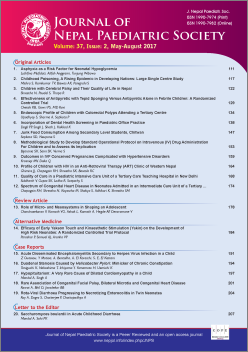Childhood Poisoning, A Rising Epidemic in Developing Nations: Large Single Centre Study
DOI:
https://doi.org/10.3126/jnps.v37i2.16843Keywords:
accidental, childhood poisoning, envenomation, keroseneAbstract
Introduction: Poisoning is a major problem in children. The aims of this study were to determine the pattern of poisoning in children along with seasonal incidence, duration of treatment and outcome in referral centre of eastern India.
Materials and Methods: All the children admitted to paediatric ward of MKCG Medical college and hospital from 1st April 2015 to 31st March 2016 (1 year) with history or suspicion of poisoning and animal bites were included in the study. Brought dead patients and the children with side effects due to ingested drugs in prescribed amount were excluded from the study.
Results: Total 530 cases were documented with highest incidence in rainy season. 1-6 years children were mostly vulnerable (42.6%). Accidental mode was the major cause in small children and suicidal, in older. Animal bites and stings (n=241) were the commonest followed by chemical poisonings. Kraits were commonest culprit in snake envenomation group. Alprazolam was most common drug causing drug overdose. Total numbers of death were 27. Major cause of death was organo- phosphorus poisoning (OP) and snakebite. Mean days of hospitalization was 2.5 days and death after hospitalization was 1.8 days.
Conclusion: Most of the childhood poisonings were due to accidental cause. Animal bites were mostly due to snakes. Maximum numbers of deaths were due to OP poisoning. Watchful observation, clean and clear environment, understanding the problems of adolescence, friendly atmosphere in home can prevent most of the poisonings and animal bites in children.
Downloads
Downloads
Published
How to Cite
Issue
Section
License
Authors who publish with this journal agree to the following terms:
Authors retain copyright and grant the journal right of first publication with the work simultaneously licensed under a Creative Commons Attribution License that allows others to share the work with an acknowledgement of the work's authorship and initial publication in this journal.
Authors are able to enter into separate, additional contractual arrangements for the non-exclusive distribution of the journal's published version of the work (e.g., post it to an institutional repository or publish it in a book), with an acknowledgement of its initial publication in this journal.
Authors are permitted and encouraged to post their work online (e.g., in institutional repositories or on their website) prior to and during the submission process, as it can lead to productive exchanges, as well as earlier and greater citation of published work (See The Effect of Open Access).



